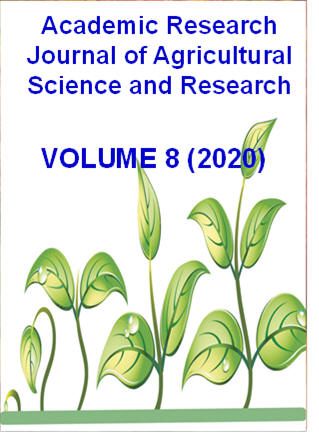|
ISSN: 2360-7874 |
Academic Research Journal of
Agricultural Science and Research |
|||||||||||||||||||
|
Vol. 8(4), pp. 361-377, May 2020 Research Effect of Blended NPS and Nitrogen Fertilizers rates on Yield Components and Yield of Tef [Eragrostis tef (Zucc.) Trotter] at Adola District, Southern Ethiopia
Yared Tesfaye 1*, Yibekal Alemayehu 2, Kiya Adare 2
1Oromia Agricultural Research Institute, Bore Agricultural Research Center, Ethiopia, P.O. Box 21, Bore, Ethiopia, Email: yaredtesfa1990@gmail.com 2 Haramaya University, School of Plant Sciences, P.O. Box 138, Dire Dawa, Ethiopia
Accepted 28 May 2020
Field experiment was carried out at Adola District during the 2018 main cropping season to investigate the effect of blended NPS and N fertilizers rates on yield components and yield of teff and to identify the economically feasible rates of blended NPS and N fertilizers for high yield of teff production in the study area. The treatments consisted of factorial combinations of four levels of blended NPS (0, 50, 100 and 150 kg NPS ha-1) and four levels of nitrogen (0, 23, 46 and 69 kg N ha-1) fertilizer rates. The experiment was laid out as a randomized complete block design with three replications. Analysis of the results revealed that total tillers (TT), productive tillers (PT), thousand kernels weight (TKW) and lodging index (LI) were highly significant (P<0.01) for the main effect of NPS as well as the main effect of N; while aboveground dry biomass yield (BMY), grain yield (GY) and straw yield (SY) were highly significant (P<0.01) only by the main effect of NPS. The maximum TT (1291 plant m-2), PT (1192 plant m-2), BMY (10038 kg ha-1) GY (2162 kg ha-1), TKW (0.3549 g), SY (7876 kg ha-1) and LI (70.83%) were recorded at the highest rate of blended NPS (150 kg NPS ha-1). Similarly, the maximum TT (1232 plant m-2), PT (1138 plant m-2), TKW (0.3446 g) and LI (66.67%) were recorded at the highest rate of N (69 kg N ha-1). The interaction of the two fertilizers were also highly significant (P<0.01) for days to 90% maturity (DM) and panicle length (PL) and significantly (P<0.05) affected by days to 50% panicle emergency (DPE) and plant height (PH).The highest DPE (49 days) and DM (86.33 days) were obtained from unfertilized (control) treatments. Maximum PH (105.72cm) and PL (43.33 cm) were recorded at combined application of 150 kg NPS with 69 kg N ha- 1, respectively. Economic analysis result showed that combined application of 150 kg NPS and 46 kg N ha-1had gave highest economic benefit of 61315.41 Birr ha-1 with the marginal rate of return of 852.50%. Therefore, use of 150 kg NPS and 46 kg N ha-1 was recommended for production of teff in the study area.
Keywords: Blended Fertilizer, Teff, Yield and Partial budget Analysis
How to cite this article (APA Style): Yared T., Yibekal A., Kiya A (2020). Effect of Blended NPS and Nitrogen Fertilizers rates on Yield Components and Yield of Tef [Eragrostis tef (Zucc.) Trotter] at Adola District, Southern Ethiopia. Acad. Res. J. Agri. Sci. Res. 8(4): 361-377
|
|||||||||||||||||||
